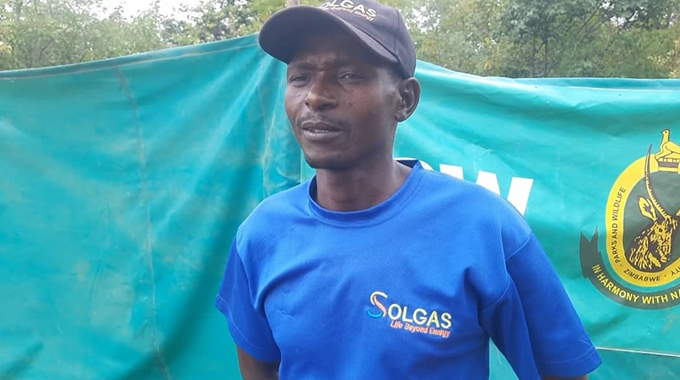WATCH: Hwange villagers welcome tech-driven solution to elephant conflict

Gibson Mhaka
VILLAGERS in Dopota, Ward 17 of Hwange East in Matabeleland North province have welcomed efforts by the Zimbabwe Parks and Wildlife Management Authority (Zimparks) and the International Fund for Animal Welfare (IFAW) to curb human-wildlife conflict in the area.
Watch here : https://youtu.be/vv8Wuv2pBDo
These efforts meant to promote a peaceful co-existence between people and wildlife involve using cutting-edge GPS technology to track elephant movements around the communities bordering Hwange National Park.

Dr Henry Ndaimani
The villagers have been enduring decades and decades of human-wildlife conflict. Most of them lost lives as wildlife left behind a trail of untold destruction. The technology comes in handy, with experts anticipating that the construction and completion of the Gwayi-Shangani Dam, less than 50km east of the Hwange National Park will alter elephants’ movement and curb human-wildlife conflict within the surrounding communities.
The use of this technology is being implemented through an elephant collaring operation, which began on Monday last week and is expected to run for 15 days. The operation will target six matriarch elephants that lead family herds in the communal areas between Hwange National Park and Sikumi and Mzola Forest reserves and two bull elephants.
Lift Sibanda (45) commended Zimparks and IFAW, highlighting that this initiative will address the human-wildlife conflict that has been affecting villagers for so long.
Watch here : https://youtu.be/Qh0MO_9BmyU
“Human-wildlife conflict is a thorn in our flesh for us villagers here. I lost four cattle, and every year when I planted crops, elephants destroyed them. We heard that Zimparks and IFAW are now collaring elephants to monitor their movements. We believe this will help us as villagers because when elephants approach our area, they can be easily detected, and swift action can be taken,” said Sibanda.
Another villager Gedion Dube (76) who was trampled by elephants in 2021 said if the exercise is implemented properly, it will go a long way in resolving some of the silent conflicts affecting the families of the victims.

Daphine Madlamoto
“In 2021, elephants trampled me, fracturing my right knee. Though I’ve recovered, walking and supporting my family through work is difficult. Proper implementation of this programme would greatly help resolve the unspoken struggles faced by victims’ families,” said Dube.
Philip Ngwenya (57) expressed his belief that the programme will lead to a decrease in wildlife crimes within the area.
He explained that with the reduced threat posed by elephants to their livelihoods, villagers will no longer feel pressured to hunt wild animals.
“To deter elephants, we currently resort to burning dry dung and sprinkling it with chilies at night. We believe this elephant collaring programme will significantly reduce human-wildlife conflict, and we also hope for a significant improvement in our crop yields once it’s fully implemented,” he said.
Zimparks principal ecologist, Daphine Madhlamoto who is part of the research team and operation outlined the goals of the collaring exercise. These include monitoring elephant movements, habitat use, and their overall utilization of the landscape.
“So we will be checking these collared elephants online and we will be able to track their movements and identify the resources they utilise outside the game park boundaries. This allows us to alert communities when elephants move into communal areas, thereby preventing potential conflicts. Additionally, we can monitor interactions between humans and elephants to gain valuable insights for future management strategies,” said Madlamoto.
She explained that the collaring exercise was important given the construction of the Gwayi-Shangani Dam as the game park relies on artificial water sources, elephants may be more likely to venture outside protected areas in search of water.

Philip Ngwenya
“This region has a growing elephant population. Since the Hwange National Park relies on artificial water sources and with this increasing elephant population, there’s also a concern about the upcoming Gwayi-Shangani Dam. As elephants are highly dependent on water, a permanent lake at Gwayi-Shangani may attract them, leading to more elephants moving outside protected boundaries in search of water. This could significantly increase human-wildlife interactions,” she said.
IFAW’s programme manager for landscape conservation, Henry Ndaimani, said their goal was to study how elephants use the area northeast of Hwange National Park and to gain insights into their current use of this landscape and how it might change once the Gwayi-Shangani Dam is complete.
“Our objective is to understand how elephants utilise the area northeast of the park. This area is crucial because it’s experiencing significant changes: human settlements are expanding, agricultural activity is increasing, and developments like the expanding Gwayi-Shangani Dam are underway. We believe these changes will likely alter the movement patterns of elephants and other wildlife.
“By collaring and monitoring the elephants, we hope to gain insights into their current use of this landscape and how it might change once the dam is complete. This information is vital for maintaining a stable elephant population and a healthy ecosystem,” said Ndaimani.
He added: “This area is a shared space for wildlife and people, and as you know, co-existence comes with challenges. Human-wildlife conflict is a major concern, so we also want to understand how elephants interact with human activity. If our monitoring is successful, we can develop an early warning system to alert communities when elephants are approaching crop fields, allowing them to take preventive measures”.
According to ZimParks, the elephant population in the game park is more than 50 000, far beyond its holding capacity of at least 15 000.










Comments